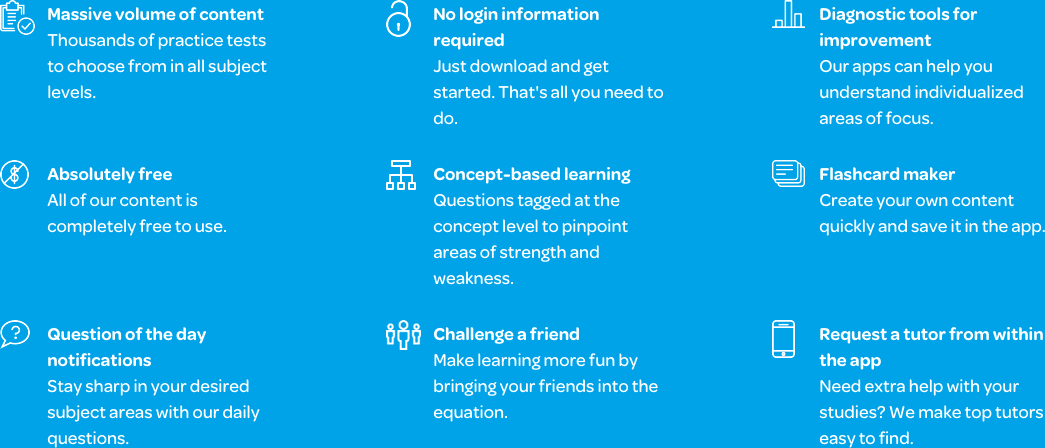The Varsity Tutors AP Environmental Science Mobile App
Students in the AP Environmental Science program learn about the natural world. The course includes fieldwork and lab experiments. From manmade problems to natural issues and their impacts on ecological systems, students increase their mental aptitude in these areas. The knowledge they attain builds on the basic topics they have previously learned. One great resource to help students with material that often seems challenging is the free Varsity Tutors AP Environmental Science app for Android, iPhone, and iPad.
Field experts have contributed content for the app’s practice questions, flashcards, Learn by Concept, and full-length practice tests. These can all be accessed through the app in just a few taps. The app gives you the opportunity to enhance your knowledge of biodiversity, ozone formation, and geothermal energy, among many other topics.
The app also has tools that can challenge you. Timed practice exams can gauge your speed and give you practice with the real test’s format. Take several tests on your mobile device and receive instant feedback on your performance. This way, you’ll see both your strongest topics and those on which you need more work. Detailed explanations show the reasoning for the correct answer. You can also track your scores and performance over time, share the results, and take advantage of other valuable resources on your Android device, iPhone, or iPad.
Adequate preparation is essential for success. The AP Environmental Science Exam must be completed in three hours. It is comprised of two sections. Section I is a set of 100 multiple-choice questions, and counts for 60 percent of the test’s overall score. You will have 90 minutes to answer all of the questions. Some of them stand alone, and others are combined in sets, where you will have to call on your knowledge of the materials’ themes.
You will have another 90 minutes to complete Section II, which includes four questions. Accounting for 40 percent of the total score, it includes a data set, document-based question, and two questions requiring synthesis and evaluation. Your understanding and knowledge of environmental science will be thoroughly tested, so it’s important to use your study time wisely by dividing it between classwork and practice with the resources available through the Varsity Tutors AP Environmental Science app.
The AP exam will test you on topics including nature, evolution, biology, and ecosystems. Various natural cycles are covered, too, and you’ll need to brush up on your knowledge of ecology and the elements that influence the natural world. Other topics to focus on include the ecological and economic consequences of pollution, thermodynamic laws, among many more. Proper preparation requires having the right study materials at your disposal and the ability to personalize your study plan. Review the app’s materials at length, or take just a few minutes out of your busy schedule to mix a little AP Environmental Science review into your daily routine.
You’ll build a better understanding of the material and get the most out of the app by asking yourself questions. Download the free Varsity Tutors AP Environmental Science app for Android, iPhone, and iPad on iTunes or the Google Play Store today, and get started on shoring up your knowledge in advance of the exam.
66 mobile apps to choose from for your tutoring needs.

Learn More
Advanced Placement courses are designed to provide you with preparation for college-level learning and allow you to earn college credits at some institutions before setting foot on campus. AP Environmental Science is a semester-long class that can help you get a leg up in a variety of programs, such as environmental studies, geography, chemistry, geology, and biology. Upon completion of the course, you are able to get into more advanced environmental science classes when you start college.
AP Environmental Science is a class that weaves several concepts from many areas of study into a single program. Depending on the program, your course may emphasize different principles. Some focus more on the scientific aspects, such as analysis and lab work. Others may emphasize the political or sociological stance of a topic. You learn the many topics associated with the resources and systems of the Earth, the living world, land and water use, population, our energy resources and consumption levels, pollution, and global change. In addition, you will be given opportunities to experience lab and field investigation. There is no mandatory chronology of the program. The science portion of AP Environmental Science requires that you participate in field investigation and laboratory components of the program. You will need to be able to observe systems in the environment; conduct well-developed experiments; demonstrate techniques and the ability to adapt to different observatory instruments; perform analysis and interpretation of data sets in graphs and statistics; apply various concepts to recognize a solution to environmental issues; arrive at conclusions, determine validity, and evaluate quality; propose studies; and form clear, accurate, and meaningful observations and conclusions.
At the end of your AP Environmental Science course, you will be tested on the major topic areas to assess your knowledge and understanding of the subject. You have three hours to complete the two-section exam. The first section covers 100 questions. You get 90 minutes to answer multiple-choice discrete questions and questions in sets. The second section contains four free response questions: one data set, one document-based, and two synthesis and evaluation questions. You can receive a score of 1-5. During the multiple-choice question portion of the AP Environmental Science exam, you are scored based on the number of questions you answer correctly. The problems on the test may be based on a basic fact, fundamental concept, or major idea. In the free response section, you must display a deeper comprehension of the principles and their application. Your responses must be analytical and well-reasoned, with several resources.
There are seven main concepts that you will be learning in AP Environmental Science. Each of these can be broken into smaller, more specific ideas to focus on. During the first several weeks of AP Environmental Science, your teacher may focus on the primary notions of Earth Science. Earth science focuses on natural events in the ecosystem, the atmosphere, soil, and the atmosphere. You will need to be able to identify the natural selection processes in the world today, along with the impact that humans have on these changes.
As you progress, your class may next focus on the ecosystem. During that time, you’ll need to be able to identify and discuss the ecosystem and how it affects the planet. It is during this section that you will learn about biogeochemical cycles, how these affect the water cycle, and all about the keystone species.
The third major topic in AP Environmental Science covers the basics of population. Population focuses on the planet’s carrying capacity, reproductive strategies, population ecology, and survivorship. You will learn about the dynamics involving the human species, such as historical growth and populations, age groups, doubling times, and others. You need to be able to comprehend and discuss topics of sustainability. In addition, you’ll analyze case studies to form coherent arguments on how population growth can be effected by the economy, resource use, and destruction.
Next, your class will focus on the way the planet’s land and water is used. There are many key ideas you will learn about during the weeks spent on this aspect of the class. You’ll need to know different strategies that can be used to feed a budding population. Further, you must be able to back the strategies up based on the human body’s nutritional requirement, current farming processes, sustainability, and agricultural types. Simultaneously, you’ll learn about the laws that are in place to regulate farming, pesticide use, genetic mutation, and more. Lastly, you need to become familiar with uses for the land, such as transportation, urban cities, federal and public territory, forestry, and mining. Your class will be tasked with identifying the impact these many uses have on the ecosystem.
The next topic you will learn in AP Environmental Science focuses on the planet’s energy resources, the current use of these resources, and our predicted consumption. During this time, your teacher will go over relevant concepts like the Laws of Thermodynamics, historical energy consumption during the Industrial Revolution, and how exponential growth can lead to an energy crisis. You will need to be able to list the types of nonrenewable resources we have and how we harvest them, how these benefit and cause problems, and the current reserve levels. In addition, you may spend additional weeks on renewable resources, conservation strategies, and different types of power.
The following month or two is spent focused on pollution. There are several types of pollution, and you’ll need to be able to recognize these, as well as their sources. You will learn to cogently discuss the strategies available for reducing pollution and how to back up these strategies with relevant laws, quality maintenance measures, and other evidence. Furthermore, you’ll be taught about the damage that can be caused by pollution in terms of humanity, the economy, and the planet itself. Your teacher will expect you to be capable of debating the ozone layer, the treaties and laws associated with our atmosphere, and global warming.
During the laboratory portion of AP Environmental Science, you will develop skills through hands-on, first person experience. You are tasked with testing the many principles that you learn during the program to achieve a deeper understanding of them. Through these, you will explore problems that you otherwise couldn’t in a classroom to achieve a greater idea of the real-world applications these topics have. You will participate in activities that are linked to one of the major concepts, provide a direct interaction with the system or organism, and observe the results. All laboratory materials should be kept in order to ensure that you get the credit.
There are many benefits that come with an AP Environmental Science class. The hands-on experiments and field work opportunities can give you invaluable experience related to future careers. Moreover, you can use the program to jumpstart your college career.




